Our Seafood Workforce Development Plan contains further analysis of Industry, Workforce and Learner data trends.
Seafood industry trends
The industry is poised for growth, with rising export demand driven by global economic recovery post-COVID-19 and a focus on Aquaculture by government.
New Zealand’s seafood industry is a significant earner for the economy. Aquaculture is set to take centre stage over the next five years and is likely to be a key driver of the industry’s performance1. In Marlborough, for instance, the aquaculture industry has a considerable presence, with more than half of New Zealand’s production of both Pacific Salmon and Greenshell Mussels2. Seafood accounted for 4% (NZ $1,919 million) of the total export revenue in the food and fibre sector for the year ending June 2022 and is forecast to increase by 4% to $2 billion in 2023. After a challenging period of dealing with the effects of COVID-19, the industry is forecast to expand over the next five years, due to increasing demand from Asian export markets and the aquaculture industry becoming increasingly important.
Seafood is a significant sector for Māori, with nearly a third of businesses in the industry owned by Māori, as well as significant investment in land-based processing operations and aquaculture3.
Seafood workforce trends
Both the seafood production and seafood processing sectors are forecast to increase by at least 3% and 10% respectively by 2032. The forecasts show significantly higher required increases (21%- 35%) for higher skill role types that will require increased levels of training. The workforce currently has low levels of formal qualifications and would need a substantially higher than requested level of investment to reach industry benchmark parity (see Appendix C for more detail on the methodology). The workforce has low new entrant retention rates and low levels of industry tenure which drive a need for training of replacements. The sector has very significant reliance on those on temporary & work visas making the industry vulnerable to changes in immigration trends and policy shifts.
Seafood workforce overview and highlighted demographics
In 2020 there were 16,482 individuals working in the Seafood industries – Māori represented one quarter (25%) of the Seafood workforce, followed by 16% Asian and 8% Pacific peoples4 making it one of our more ethnically diverse workforce. Immigration is an important source of labour. There are key challenges affecting the sector such as attracting New Zealanders into the industry rather than relying on foreign workers to fill the gaps where there are ongoing labour and skills shortages across a variety of roles5. The seasonal nature of some roles also limits the opportunities for full-time employment.
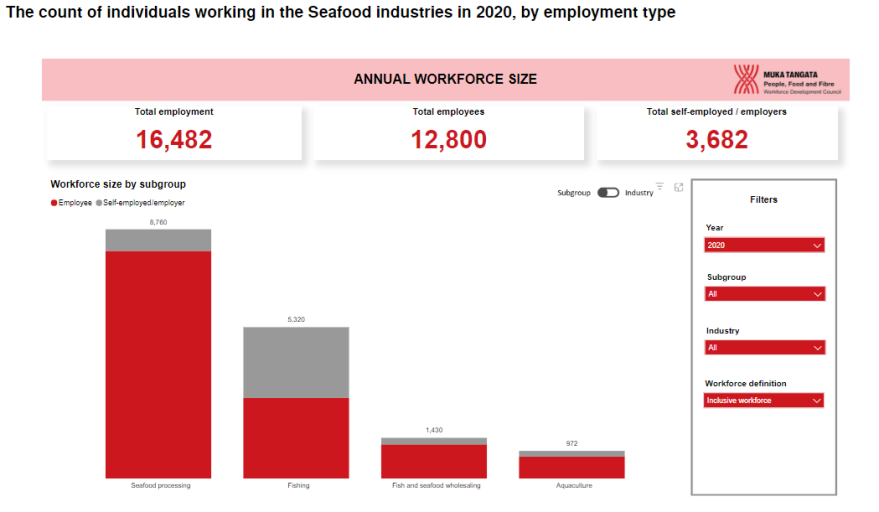

Seafood workforce forecasts
MPI forecasts, using the conservative ‘BAU Scenario’, are for an increase in worker numbers – particularly in higher skill level roles. We have mapped these forecasts to the roles and related qualifications for each of our industries and used them as an input to the level of increase requested for each qualification. See Appendix A: Translating MPI workforce forecasts to learner enrolment numbers for more details.
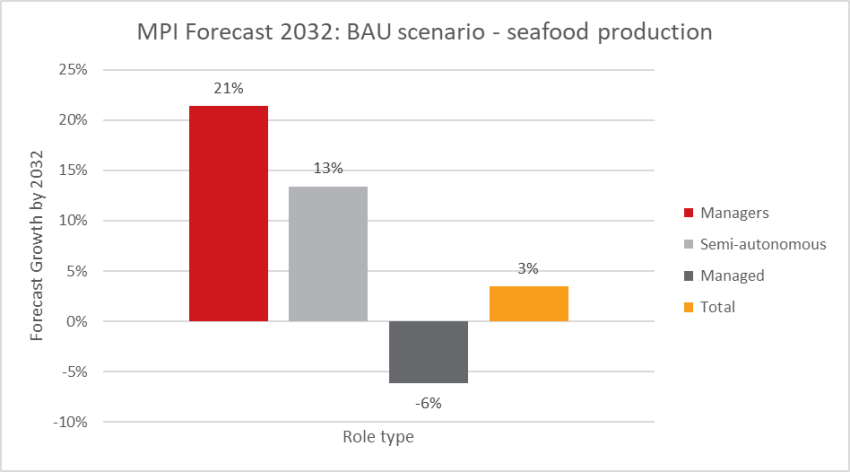
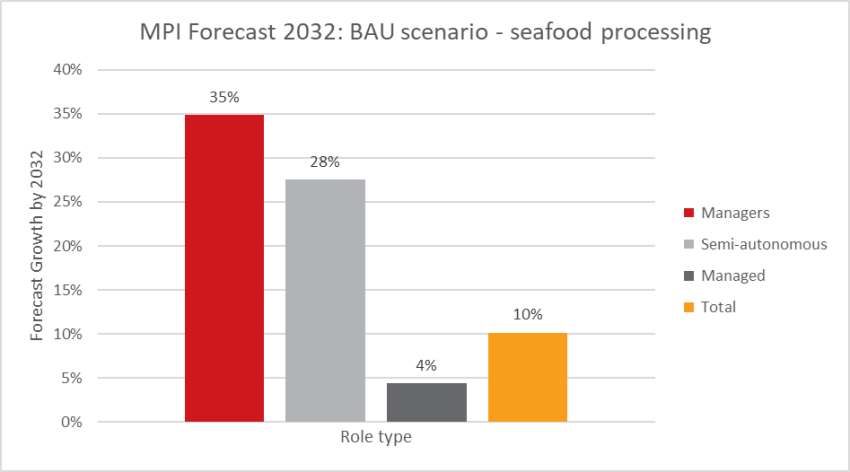
Seafood workforce retention and tenure
The Seafood workforce has a low level of new entrant retention and a low level of industry tenure. This replacement demand also is a driver of training requirements in this industry. This training is not lost to the sector – over a third of new entrants to Muka Tangata industries come from another Food & fibre industry and our qualifications are increasingly focused on transferable skills. Specialised education and retention are associated with retention – so increased training is expected to support retention within the industry and broader sector.
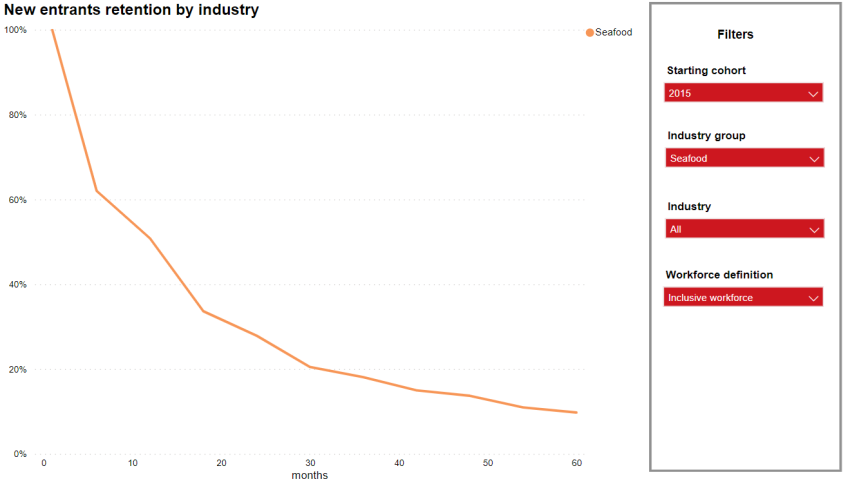
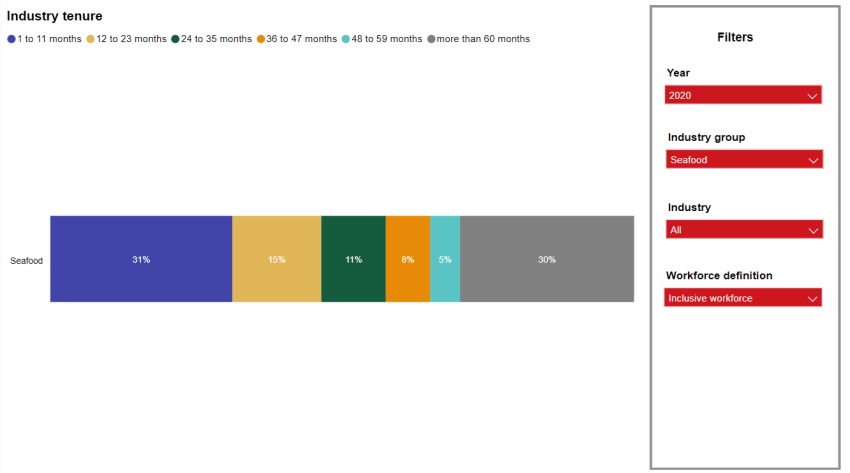
We are reviewing the seafood qualification suite. Our expectation is that new qualifications will be available in 2024. Learner numbers have plummeted over the last decade and the current qualifications are in general not well supported through enrolments. Until the new qualifications and new programmes are available, however, we welcome any increase in enrolments in the existing qualification set. Except for a few qualifications set out below, we are not in a position to determine the quantum of any increases for most of the existing qualifications. But, by way of comparison, in 2011 there were close to 2,500 learners, whereas in 2022 there were only approximately 500.
Below we set out the one qualification that has had sufficient enrolments to establish a trend. We list the other qualifications below that.
We note that aquaculture has been identified as a growing area (as also noted by Marlborough and Bay of Plenty RSLGs) See also the Government’s Aquaculture Strategy (The Government’s Aquaculture Strategy to 2025 (mpi.govt.nz)).
Which specific qualifications and credentials do you want to see growth in (that can be supported by TEC investment in 2025)?
| Qualification or credential | Mode | Specific regions? | Scale of change you are seeking for 2025 | Evidence of workforce need – include as text below the table or an attachment | Evidence that this provision will meet the workforce need | WDC-assigned priority level (for this advice) |
| New Zealand Certificate in Seafood Processing (Level 3): Fish and Fish Products, Live Holding, Cleaning and Sanitation, and Seafood Logistics [3130] | All regions – but note RSLG specifics: West Coast (they consider offers a career pathway for learners, particularly for female and Māori learners); Nelson Tasman. | 10-15% | There is demand from industry driven by forecast industry and workforce growth across the related industries, significant gaps in the qualification level of the workforces and demand driven by high rates of new workers constantly needing to be brought into the industries and upskilled. MPI workforce forecasts have identified that the seafood processing industry needs to hire more people to keep up with the demand for seafood processing that stems from the growth in seafood production. |
The New Zealand Certificate in Seafood Processing (Level 3) provides the seafood processing sector with people who are able to work as operators carrying out routine operations involving either seafood processing, live holding, cleaning and sanitation, or logistics in a seafood processing operation on land or at sea. | High |
|
Other qualification in the seafood suite where there are no or low enrolment numbers or where any increase would be very small. We do not expect there to be large demand for these qualifications, but want to ensure that any extra enrolments are funded. We welcome discussion on any proposed delivery numbers that seem excessive. The qualifications are: |
|
Medium Priority |
|
Medium Priority |
|
Medium Priority |
|
Medium Priority |
|
Medium Priority |
Which specific qualifications and credentials do you want to see changes in?
As we note in our overarching advice, we have not been specific about mode at a qualification level. However, in general, we recommend a preference for workplace training as part of the mix of the provision across all of our industries. This could include both work-based training and campus-based learning that include a strong component of practical ‘on job’ experience in a workplace setting.
| Area of provision and/or qualification/ credential name (if known) | Level | Mode (if specific) | Qualification or micro-credential | Estimated date it will be available | Description of content (10–20 words) | Name of qualification or micro-credential this will replace (if relevant) |
| Seafood Qualification Suite Review: including stackable MCs | Should be available in 2024 | A comprehensive review of all the seafood qualifications – including incorporate te ao Māori and mātaraunga Māori into the qualifications, is currently underway. |
| Other Seafood MCs also under development as part of the Seafood Qualifications Suite Review: |
| Seafood – Intro to Aquaculture MC L2 | Level 2 | Should be available in 2024 | ||||
| Seafood – Intro to Commercial Fishing MC L2 | Level 2 | Should be available in 2024 | ||||
| Seafood – Intro to Seafood Processing MC L2 | Level 2 | Should be available in 2024 | ||||
| Seafood – L3 2x MC processing skills - Commercial Fishing/Seafood Processing – factory vs deepsea (working with Hanga Aro Rau) | Level 2 | Should be available in 2024 |
Footnotes
1. IBIS World - Report on Fishing and Aquaculture (page 9)